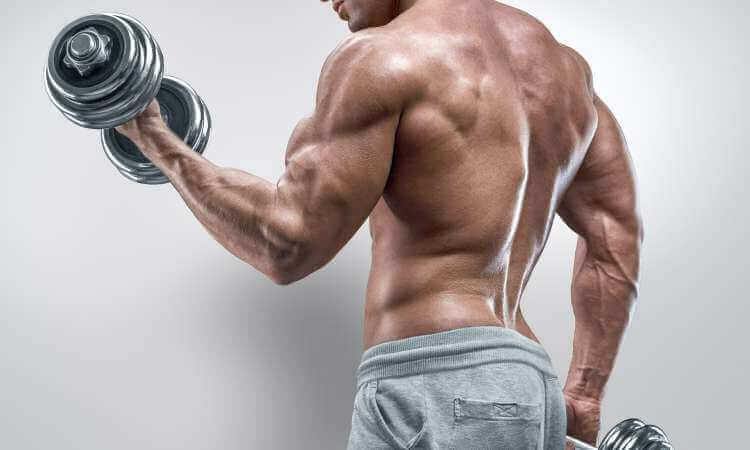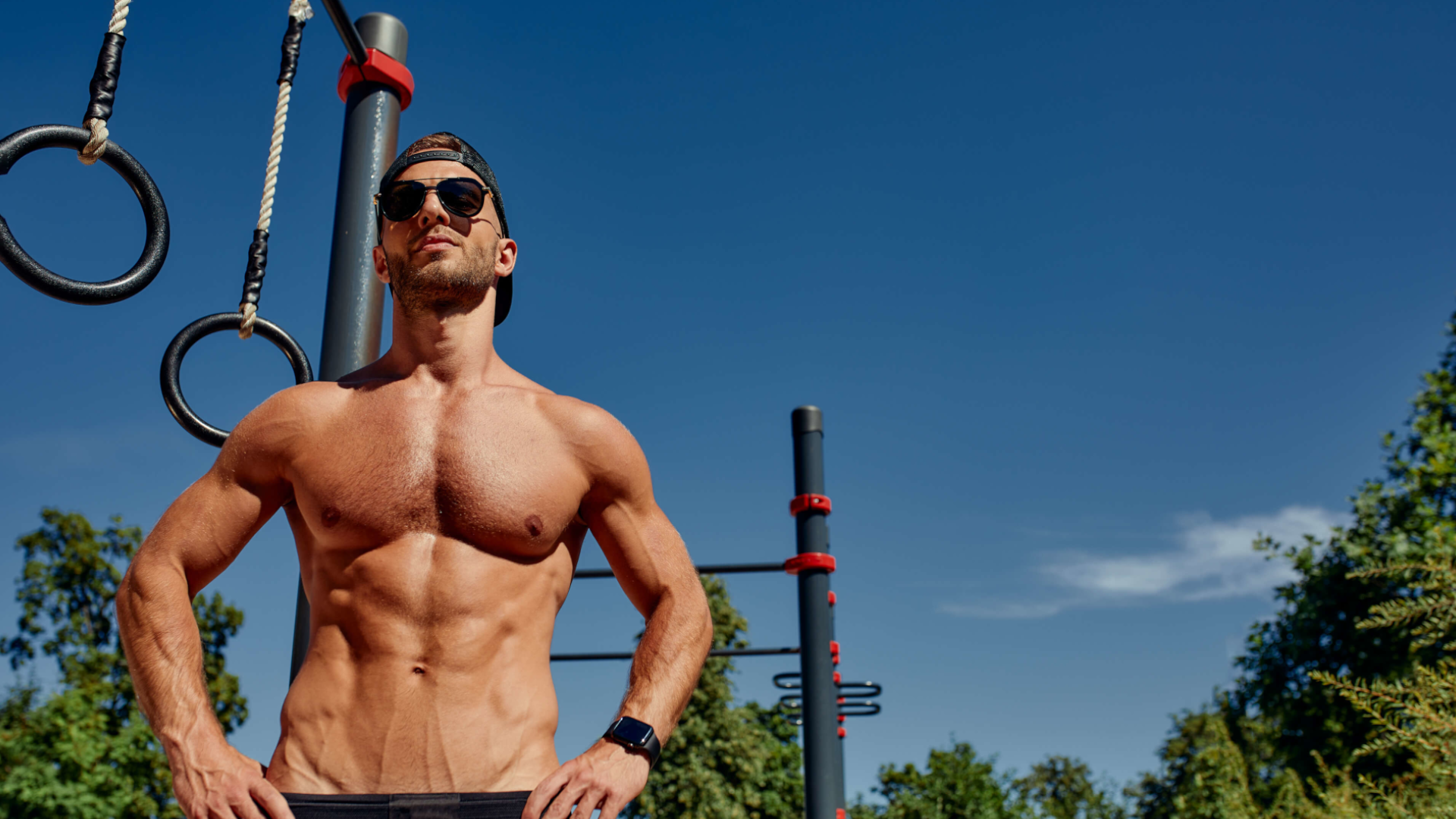Full Body Dumbbell Workout
A full-body dumbbell workout is a highly efficient and time-saving way to improve your overall fitness. A full body workout, like a dumbbell only workout, targets all major muscle groups and can be adapted to accommodate a variety of fitness levels and objectives. Incorporating various exercises such as squats, lunges, and deadlifts with dumbbells can lead to increased efficiency and improved cardiovascular health. Whether you’re a beginner or a seasoned gym-goer, a full-body dumbbell workout can help you build muscle and strength.
1. Chest presses

Sitting chest presses
Sit on the floor, holding the dumbbells by your sides. Keep your upper arms tight to your sides and carefully hoist the weights up by your chest.
Back chest presses
Slowly lower yourself down onto your back and extend your legs out straight.
Move your arms out to your sides with your elbows bent 90 degrees and palms facing your feet. Your upper arms should be pressed against the floor at this point.
Push the dumbbells straight up and toward each other in an arcing motion. Stop when your arms are fully extended and the bells are about an inch apart. Hold for a split second, slowly lower the weights back to the starting position and repeat.
2. Military press

Stand with your feet about hip-width apart and hoist the dumbbells up to the sides of your shoulders with your palms facing forward. Your elbows should be bent and your upper arms should be tucked in by your sides.
Push the weights straight upward and toward each other in an arcing motion. Stop when your arms are just about fully extended and the bells are about an inch apart. Slowly lower the weights back to the starting point and repeat.
3. Push-up renegade rows

Place two dumbbells on the floor about shoulder-width apart and with the handles parallel to each other. Grasp the handles and assume a plank position with a straight line from the back of your head to your heels.
Lower yourself down by bending your elbows and stop when your upper arms are about parallel to the floor. Push yourself all the way back up and then lift the dumbbell in your right hand up by your side. Make sure to keep your arm close to your body as you do this.
Slowly lower the dumbbell back to the floor, do a row with your left arm and repeat the entire drill.
Don’t let your hips sag or raise really high throughout the entire exercise. You can prevent this by keeping your abs really tight the entire time.
4. Sumo squat hammer curls

Grab a pair of dumbbells and stand with your feet in a wide stance with your toes facing out about 45 degrees. Let your arms hang straight down in front of your body with your palms facing in.
Keep your back straight and bend your knees to lower yourself down into a squat. Stop when your thighs are parallel to the floor, then stand back up.
As soon as your knees are fully extended, bend your elbows and lift the weights up toward your chest. Keep your palms facing each other when you do this.
Stop for a second and squeeze your biceps. Then slowly lower the weights back down and twist your wrists so they face in. Repeat the entire drill for a set of reps.
5. Triceps kickbacks

Hold two dumbbells at your sides with your palms facing in and stand with your feet together. Bend forward at the hips and bend your knees slightly. Raise your arms up backwards so your upper arms are about parallel to the floor and close to your sides.
Keep your upper arms still as you straighten your arms. Stop when your arms are fully extended and squeeze your triceps for a full second. Bend your elbows to lower the weights back down and repeat.
Ready to build some home-grown bulk?
These exercises will do a top job of targeting all your major muscle groups. If you literally just did these 5 moves two or three times a week, you’d get all the stimulation you need for toning up your body all over.
Just be sure the load you use for each drill varies. You can get away with using heavier weights for exercises like chest presses and renegade rows. But you’ll have to use a lighter resistance for exercises like hammer curls and triceps kickbacks.
Build it up slowly, increase your reps gradually and see what you can achieve this month using these moves in addition to a good quality natural bulking stack.
What are the benefits of a full body dumbbell workout?
One of the key benefits of a full body dumbbell workout is the increased efficiency it offers. By engaging multiple muscle groups at once with a set of dumbbells, a comprehensive strength workout can be achieved in a shorter span of time. This is an excellent option for people with busy schedules as it allows them to optimize their full-body workout in less time.
In addition to efficiency, a full body dumbbell workout is time-saving. With a well-planned routine, you can target all major muscle groups, including your upper body, lower body, and core, in a single session. This not only saves time but also ensures that you are working towards overall muscle development.
Furthermore, a full body dumbbell workout can contribute to improved cardiovascular health. When performed in a circuit style with minimal rest between exercises, it can elevate your heart rate, providing cardiovascular benefits alongside the muscular endurance and strength training aspects.
How to perform squats with dumbbells?
To perform squats in a full body workout, begin by holding a dumbbell in each hand, your palms facing inwards towards your body. Stand with your feet shoulder-width apart and ensure your core is tight. The squat begins by lowering your body as if you are about to sit in a chair, keeping your weight in your heels and your chest up. Engage your glutes and hamstrings to return to the starting position.
Proper form is crucial when performing squats with dumbbells. It's essential to maintain a straight back, with your shoulder blades drawn back and down. This helps to prevent strain on your lower back and ensures that the workload is distributed effectively across the targeted muscle groups.
Squats with dumbbells can be modified to suit different fitness levels and goals. Variations such as goblet squats and front squats offer different challenges and target specific muscle groups to a greater extent. This allows individuals to tailor their workout based on their fitness level and desired outcomes.
Incorporating squats into a full body dumbbell workout offers several benefits. They primarily target the lower body, including the quadriceps, hamstrings, and glutes, while also engaging the core and upper body for stability and support during the movement.
What are the different types of dumbbell lunges?
Dumbbell lunges are a versatile exercise that can be performed in several variations to target different muscle groups. The forward lunge involves stepping forward with one leg and lowering your body until both knees are bent at 90-degree angles. The reverse lunge is performed by stepping backward, while the side lunge entails stepping to the side to target the inner and outer thighs.
Performing these different types of dumbbell lunges can effectively target the quadriceps, hamstrings, glutes, and calves. This comprehensive engagement of the lower body makes lunges an excellent addition to a full body dumbbell workout, enhancing overall lower body strength and stability.
How to execute a proper dumbbell deadlift?
A proper dumbbell deadlift begins with the correct posture and technique. Hold a dumbbell in each hand, and stand with your feet hip-width apart. Keep your back straight, shoulders back, and core engaged. Hinge at the hips to lower the weights towards the ground, maintaining a slight bend in your knees. Ensure that your palms are facing your body throughout the movement.
Common mistakes to avoid when performing a dumbbell deadlift include rounding the back, which can result in strain or injury, and using momentum to lift the weights rather than engaging the targeted muscle groups. It's important to lower the weight if you find it difficult to maintain proper form, as this helps prevent potential injury and ensures maximum effectiveness of the exercise.
The dumbbell deadlift primarily targets the posterior chain, including the hamstrings, glutes, and lower back. By incorporating this exercise into a full body dumbbell workout, you can effectively strengthen these muscle groups, contributing to overall lower body strength and stability.
What is the recommended rep range for a full body dumbbell workout?
The recommended rep range for a full body dumbbell workout may vary based on individual fitness goals. For muscle endurance, a higher rep range of 12-15 repetitions per set is typically recommended. This helps to improve muscular endurance and stamina, contributing to better overall fitness and resistance to fatigue during daily activities.
On the other hand, for individuals looking to build muscle, a moderate rep range of 8-12 repetitions per set is often recommended. This range is conducive to hypertrophy, stimulating muscle growth and strength development over time. Alternating between these rep ranges within your workout routine is important for overall muscle development and progression.
Varying rep ranges within a full body dumbbell workout is important to challenge the muscles in different ways, promoting continuous adaptation and growth. It also helps to prevent plateaus and maintain motivation by introducing variety into the training regimen.
What are the best dumbbell exercises for building muscle?
The best dumbbell exercises for building muscle typically focus on engaging multiple muscle groups simultaneously. Compound exercises such as dumbbell rows, renegade rows, and overhead press are highly effective for targeting various muscle groups in the upper body, including the back, shoulders, and biceps.
Incorporating these compound exercises into a full body dumbbell workout can provide comprehensive upper body strength training, promoting balanced muscle development and functional strength. Additionally, the adaptation and progression in these exercises, such as increasing weight or varying grip positions, can further enhance muscle growth and strength over time.
Overall, a full body dumbbell workout that incorporates these best dumbbell exercises provides a holistic approach to strength training, targeting multiple muscle groups and promoting balanced muscular development.
Q: What is a full-body dumbbell workout?
A: A full-body dumbbell workout is a training routine that targets all major muscle groups using dumbbells and typically includes exercises such as squats, presses, rows, and lunges.
Q: How often should I do a 3-day full body dumbbell workout?
A: It is recommended to do a 3-day full body dumbbell workout 2-3 times per week, with at least one day of rest in between each session to allow for muscle recovery.
Q: Can I do a full-body dumbbell workout with just one dumbbell?
A: Yes, you can modify exercises and perform a full-body dumbbell workout with just one dumbbell, adjusting the movements to target both sides of the body evenly.
Q: What are some exercises included in a day full body dumbbell workout?
A: Some exercises included in a day full body dumbbell workout may be goblet squats, front squats, renegade rows, and overhead presses, among others.
Q: How can I perform a renegade row in a full-body dumbbell workout?
A: To perform a renegade row in a full-body dumbbell workout, start in a plank position with a dumbbell in each hand, then lift one dumbbell while balancing on the other hand, and alternate sides.
Q: What is the best full-body dumbbell workout routine for beginners?
A: The best full-body dumbbell workout routine for beginners focuses on foundational movements such as squats, presses, and rows, and gradually increases intensity and complexity as strength and proficiency improve.
Q: How should I hold the dumbbells for a dumbbell row?
A: To perform a dumbbell row, hold a dumbbell in each hand, keep your back straight, and bend forward at the hips while keeping your core engaged and elbows close to your body as you row the weights towards your hips.
Q: Should I increase the weight for a full-body dumbbell workout?
A: Yes, you should gradually increase the weight for a full-body dumbbell workout as you become stronger and the current weight becomes less challenging, ensuring proper form and technique are maintained.
Q: What should I focus on while performing an overhead press in a full-body dumbbell workout?
A: While performing an overhead press in a full-body dumbbell workout, focus on keeping your core tight, pressing the weights directly overhead, and keeping your elbows parallel to the floor at the top of the movement.
Q: What are the benefits of a full-body dumbbell workout?
A: A full-body dumbbell workout offers benefits such as targeting large muscle groups, improving overall strength and muscular endurance, promoting functional strength, and providing a versatile and efficient training plan.
Over 299,434 purchases
Over 509,389 bottles sold
Over 30,563,340 pills taken








